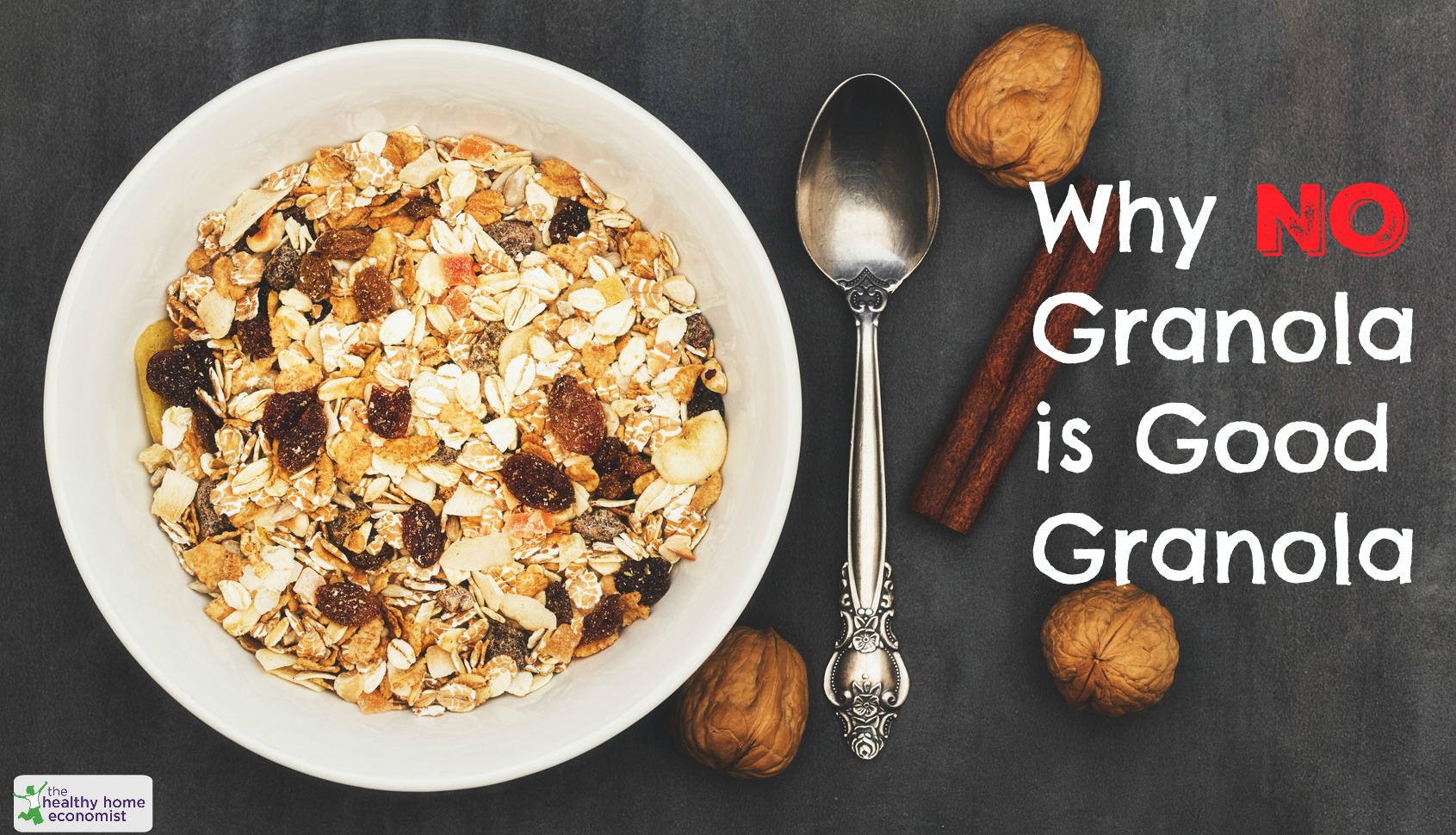Table of Contents[Hide][Show]
 Several readers have emailed me recently inquiring about how to best go about making homemade granola.
Several readers have emailed me recently inquiring about how to best go about making homemade granola.
One person carefully soaked oats for 24 hours in water with an acidic medium and then dehydrated before mixing with the other ingredients and toasting in the oven.
Another used sprouted, organic rolled oats and baked in a 200F oven with various other ingredients to make her favorite version of homemade granola.
While both of these approaches to making granola are certainly a huge improvement over any of the granolas to be had at the store, the fact is that even organic granola made with rolled oats that have been sprouted or soaked is not an easily digestible food.
The proteins in grains are extremely difficult to digest. They have the potential to cause health problems over the long term, which is why traditional societies took such great pains to soak, sprout, or sour leaven them before consuming.
Not only did traditional peoples soak, sprout, or sour leaven their grains, they also thoroughly cooked them as the final preparation step before eating.
Why Granola is SO Difficult to Digest
The dry heat of an oven at the proper toasting temperature is simply not hot enough to complete the breakdown of anti-nutrients in oats or other grains. Thus, even homemade granola is extremely difficult to digest. Eaten often, it can damage the gut over time.
Perhaps if a person has an iron gut, then homemade granola that is soaked or sprouted might work on occasion. The reality is that most people have sensitive guts anymore due to several generations of children raised on antibiotics and processed foods. Most people have some sort of digestive sensitivity to grains even if there are no grain allergy symptoms present.
I know for me, I bloat terribly if I eat homemade granola that has been soaked or sprouted and then toasted. I have no grain allergies and my digestion is in pretty decent shape. Interestingly, thoroughly cooked unsoaked oatmeal digests far better. The lesson at least to me is that the final cooking step is very important!
I have only made granola for my family once or twice. However, I stopped after observing the undigestibility of consuming this non-traditional food even when seemingly prepared in a traditional fashion.
Do your digestion a favor and opt out of any grain based granola entirely. Even homemade, organic, and soaked and/or sprouted versions aren’t good for your long term gut health.
Healthy Alternatives to Granola
Don’t hesitate to use soaked or sprouted grains that are fully cooked for all your other dishes and baked goods! This article plus video tutorial for a healthy cold breakfast cereal recipe is a very digestible alternative to granola.
Another alternative is to make grain free Paleo granola using the linked recipe.
Sarah, The Healthy Home Economist
Sources and More Information
Nourishing Traditions, p. 454
Soaked Oatmeal Benefits Without the Soaking?








At what temperature do soaked oats need to be cooked to become digestable? Why is this possible to achieve on the stove but not in the oven?
Granola is typically toasted at about 200F which is not hot enough. If you go higher in the oven … to 350F or so, it burns it or makes it too hard. On the stovetop, this temperature is easily achieved.
I am so confused. I’ve made the cold cereal and found it to have a hard, crunchy texture. It is a soaked grain that is then dehydrated. I do not understand how that is different from a sprouted grain (oats) that is then dehydrated?
The cold cereal recipe is cooked too.
Hi Sarah,
Can you provide any links to peer-reviewed research on anti-nutrients in oats?
Thank you
Hi Sarah! I make a yummy and what I thought was a healthy, simple cookie for my kids with slightly ground rolled oats and mashed banana. If I were to use soaked oats with the banana and then bake in the oven, would that suffice to make them as digestible as the cooked oats for breakfast above?
sorry, in my last sentence I was referring to another of your posts i read today on soaking and cooking oats for breaky.
Soaked oats really need to be cooked thoroughly on the stovetop before eating. Toasting only in the oven doesn’t work quite as well.
Thank you for this blog- I come to it often for guidance and ideas! I wanted to add that I have just finished making a large batch of soaked and dried buckwheat, nut, seed and fruit ‘granola’. I don’t use a lot of sweetener – just the fruit and a bit of raw honey, plus coconut oil. I only use oats for soaked oatmeal. I have tried making this granola raw and sprouted, too, but that was a LOT of work! (It was good, though.)
Hello Sarah,
Thank you for your wonderful blog! I’ve learnt so much from you. I’m curious if this granola also extends to Bircher Müsli. I like in the alps and the people consume tradtional bircher müsli regularly, that is they soak a bit of oats in yougurt and add fresh fruit the day after, or or two days later and wet it down with fresh milk. No cooking. They seem pretty healthy and robust. Maybe you’ve covered müsli already on your website and I just haven’t found it?
Many thanks,
Grüss,
Erica
Sarah, I just saw this post and wondered if this was an acceptable version? It looks more like a wet batter than the dry roasting. We love your cold cereal recipe but would love another option and thought this one might actually be an okay oats recipe?
http://thenourishinghome.com/2012/04/the-best-soaked-granola-gluten-free-option/